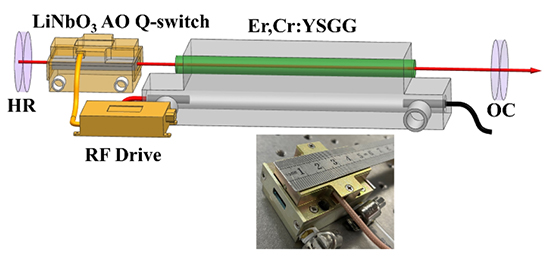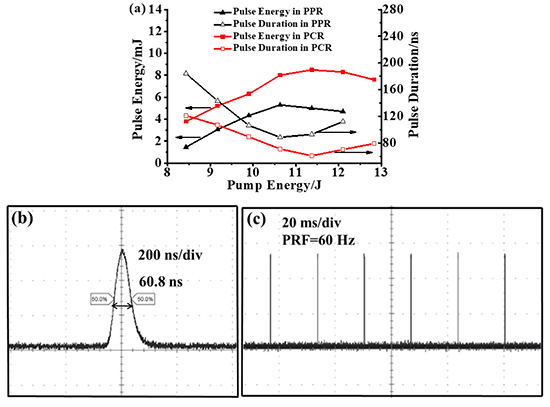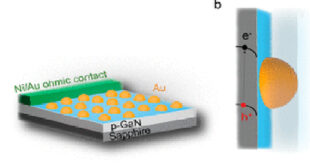Significance
Mid-infrared lasers, that operates in the 3–12 μm wavelength range have wide range of applications in medical surgery, material processing, and environmental monitoring. The extensive search for efficient, high-power mid-infrared sources has led to the exploration of various laser materials and configurations. Among these, the Er,Cr:YSGG laser crystal, emitting at 2.79 μm, has been identified as a promising active medium due to its high efficiency and suitability for economical flash-lamp pumping. The addition of Cr³⁺ ions enhance the energy transfer efficiency, making it an attractive option for high-repetition-rate, high-pulse-energy applications. Additionally, the acousto-optic (AO) Q-switching technique allows for precise control over the laser pulse’s initiation. This method is favored for its compactness, low insertion loss, and high repetition rate capabilities. However, the limitation of thermal lensing effect, caused by heat generation within the laser medium, can pose a significant challenge in maintaining high output quality under high-repetition-rate conditions because it can distort the laser beam and reduce the efficiency and stability of the laser output. To this account, a new study published in Frontiers in Physics led by Professor Jiang Haihe and his team from the Hefei Institutes of Physical Science at the Chinese Academy of Sciences, focused on addressing the thermal lensing effect in Er,Cr:YSGG lasers, which operate in the mid-infrared spectrum at 2.79 μm, utilizing a novel structure of LiNbO₃ for AO Q-switching. The team’s experiments were designed to both theoretically calculate and experimentally measure the thermal focal length within the gain medium, and to validate a resonator design that compensates for this thermal lensing effect.
The team constructed an Er,Cr:YSGG laser system incorporating a home-made LiNbO₃ AO Q-switch within a specially designed plane-convex resonator. The AO medium used was a novel structure of LiNbO3 bulk crystal, chosen for its higher transmission at 3-μm wavelength range, lower acoustic attenuation coefficient (1 dB/cm@1 GHz) and higher damage threshold (>200 MW/cm2). Taking into account factors such as the thermal conductivity of the medium, the cross-sectional area of the laser rod, and temperature gradient, the experimental setup was carefully designed to improve the output performance of the laser, reduce the risk of damage to the acousto-optic Q-switch at high repetition rates, and develop the high-performance 2.79 μm Er,Cr:YSGG laser.
Based on the theoretical and experimental insights, a plane-convex resonator design was proposed to compensate for the thermal lensing effect. The experimental results demonstrated that the designed plane-convex resonator significantly improved the laser’s performance by compensating for the thermal lensing effect. In operating in a free-running mode, the laser achieved a maximum pulse energy of 160 mJ at 60 Hz, doubling the pulse energy compared to a plane-parallel resonator setup. In the Q-switched mode using the LiNbO₃ AO Q-switch at 60 Hz, the laser reached a maximum pulse energy of 8.5 mJ, with a minimum pulse duration of 60.8 ns, resulting in an approximate peak power of 140 kW. These metrics represent a 1.6-fold increase in pulse energy and a 2.3-fold increase in peak power compared to the traditional plane-parallel resonator configuration. The improved resonator design not only enhanced pulse energy and peak power but also contributed to better beam quality and stability at high repetition rates.
The successful demonstration of thermal lensing compensation in a Q-switched Er,Cr:YSGG laser through the novel resonator design has several implications. Firstly, it showcases the potential for LiNbO₃-based AO Q-switching in enhancing the performance of mid-infrared lasers. Secondly, it opens up new avenues for the application of these lasers in areas requiring high pulse energy and precision, such as medical surgery and material processing. In conclusion, the work led by Professor Jiang Haihe successfully demonstrated that the thermal lensing effect in Er,Cr:YSGG lasers could be effectively compensated using a carefully designed plane-convex resonator, in conjunction with LiNbO₃ for AO Q-switching. This approach significantly improved the laser’s output performance, making it a promising candidate for applications requiring high peak power and narrow pulse durations in the mid-infrared spectrum. These findings contribute valuable insights into laser physics and engineering, offering a pathway to developing more efficient and powerful laser systems for scientific and practical applications.


Reference
Lingling Jiang, Zhongchao Wu, Shengjie Ma, Yongbin Zhu, Tingqing Cheng, Jiang Haihe. 2.79-μm high peak power LiNbO3 acousto-optic Q-switched Er,Cr:YSGG laser with thermal lensing effect compensation. Frontiers in Physics, 2023, vol. 11, id. 1201822
 Advances in Engineering Advances in Engineering features breaking research judged by Advances in Engineering advisory team to be of key importance in the Engineering field. Papers are selected from over 10,000 published each week from most peer reviewed journals.
Advances in Engineering Advances in Engineering features breaking research judged by Advances in Engineering advisory team to be of key importance in the Engineering field. Papers are selected from over 10,000 published each week from most peer reviewed journals.


